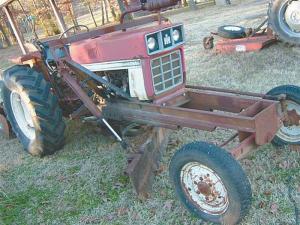Belly Blade Makes Great Grader
 ✖  |
Allen Kimball’s belly-mounted blade grades driveways smoothly without the washboarding common to rear or front-mounted blades. His customized mounting system lets him hydraulically adjust the blade for angle, tilt and even offset it to the left or right. The International Harvester 284 it is attached to has 5 speeds with hi-lo shifting, letting him slow to a crawl for grading in tight spots.
“I bought the 284 to use for large-acre finish mowing, but there wasn’t enough demand,” says Kimball. “As a contractor moving dirt, I saw a need for a very small grader. I changed the turf tires to tractor lugs and modified an old snow blade to grade dirt.”
Adding a belly blade, even a small one, required a longer wheelbase. Kimball extended the frame with 1/4-in. thick, 5-in. channel iron. He moved the front axle forward 3 ft. This required also extending the steering rod.
Two lengths of 2-in. square steel tubing welded to the bottom of the channel iron reinforce it and create a base to attach a framework for the blade housing. The framework includes 3-in. angle iron uprights that extend up and over the hood of the tractor, as well as 2-in. sq. tubing underneath the tractor frame.
He cut down the 8-ft. snow blade, retaining the original swiveling turntable, and mounted it to the housing. Kimball reinforced the top edge with 2-in. angle iron and added a hardened cutting edge to the bottom. Supports for the blade housing extend back to the rear axle of the tractor.
The blade housing hangs by hydraulic cylinders from the fabricated framework. One cylinder attached to one side of the framework extends to the opposite end of the blade. Extending or retracting it moves the entire blade housing left or right. Cylinders attached to the uprights tilt the blade ends up or down, while two small cylinders attached to the blade turntable change the angle of blade.
“I fabricated the anchor points on the uprights with double and perpendicular U-joints to allow the cylinders to move freely as the blade housing shifts,” explains Kimball. “A ball and socket connection would do the same thing.”
A steel plate installed underneath the oil pan protects it from the blade housing accidentally rising too high. The plate is attached to the underside of the extended tractor frame with angle iron.
Contact: FARM SHOW Followup, Allen Kimball. 236 Linker Mountain Rd., Dover, Ark. 72837 (ph 479 968-1236; kim2rc3gwr@centurytel.net).

Click here to download page story appeared in.
Click here to read entire issue
Belly Blade Makes Great Grader MISCELLANEOUS EQUIPMENT Miscellaneous Allen Kimball’s belly-mounted blade grades driveways smoothly without the washboarding common to rear or front-mounted blades His customized mounting system lets him hydraulically adjust the blade for angle tilt and even offset it to the left or right The International Harvester 284 it is attached to has 5 speeds with hi-lo shifting letting him slow to a crawl for grading in tight spots
“I bought the 284 to use for large-acre finish mowing but there wasn’t enough demand ” says Kimball “As a contractor moving dirt I saw a need for a very small grader I changed the turf tires to tractor lugs and modified an old snow blade to grade dirt ”
Adding a belly blade even a small one required a longer wheelbase Kimball extended the frame with 1/4-in thick 5-in channel iron He moved the front axle forward 3 ft This required also extending the steering rod
Two lengths of 2-in square steel tubing welded to the bottom of the channel iron reinforce it and create a base to attach a framework for the blade housing The framework includes 3-in angle iron uprights that extend up and over the hood of the tractor as well as 2-in sq tubing underneath the tractor frame
He cut down the 8-ft snow blade retaining the original swiveling turntable and mounted it to the housing Kimball reinforced the top edge with 2-in angle iron and added a hardened cutting edge to the bottom Supports for the blade housing extend back to the rear axle of the tractor
The blade housing hangs by hydraulic cylinders from the fabricated framework One cylinder attached to one side of the framework extends to the opposite end of the blade Extending or retracting it moves the entire blade housing left or right Cylinders attached to the uprights tilt the blade ends up or down while two small cylinders attached to the blade turntable change the angle of blade
“I fabricated the anchor points on the uprights with double and perpendicular U-joints to allow the cylinders to move freely as the blade housing shifts ” explains Kimball “A ball and socket connection would do the same thing ”
A steel plate installed underneath the oil pan protects it from the blade housing accidentally rising too high The plate is attached to the underside of the extended tractor frame with angle iron
Contact: FARM SHOW Followup Allen Kimball 236 Linker Mountain Rd Dover Ark 72837 ph 479 968-1236; kim2rc3gwr@centurytel net
To read the rest of this story, download this issue below or click
here to register with your account number.







